Pre-Registration Advising March 18 – 29
Registration April 2 – 5
Take a look at our upcoming offerings as you begin to plan. Be sure to make an appointment with your advisor if you are not sure which History classes to take in the Fall.
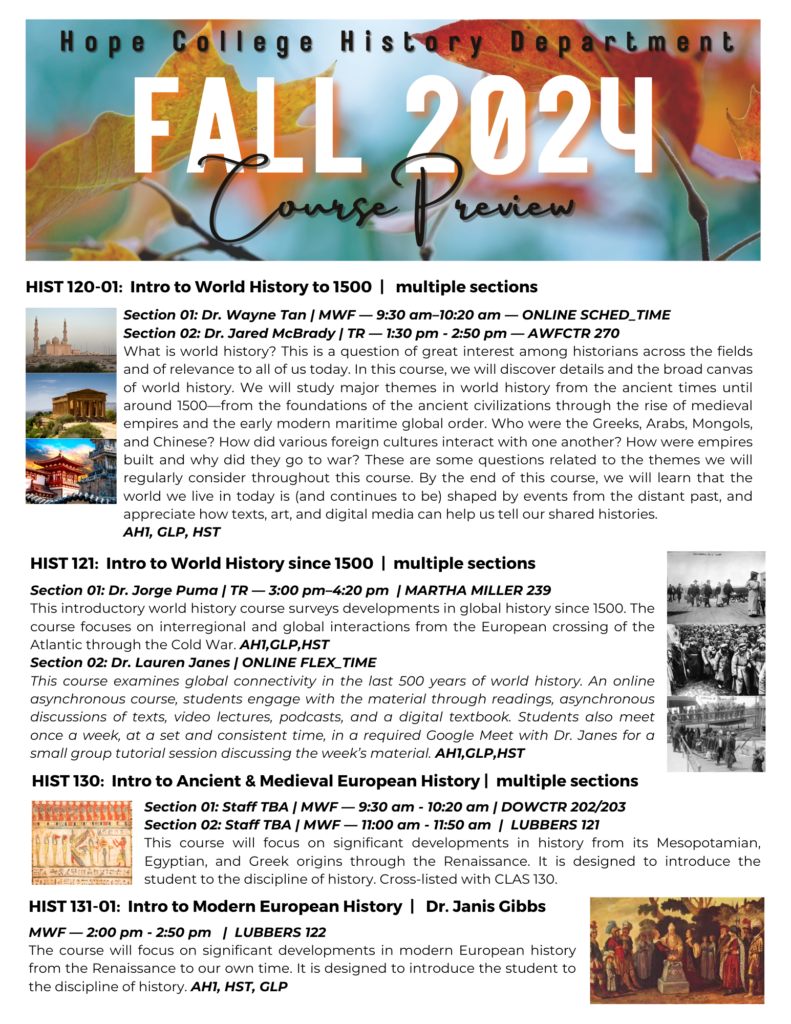

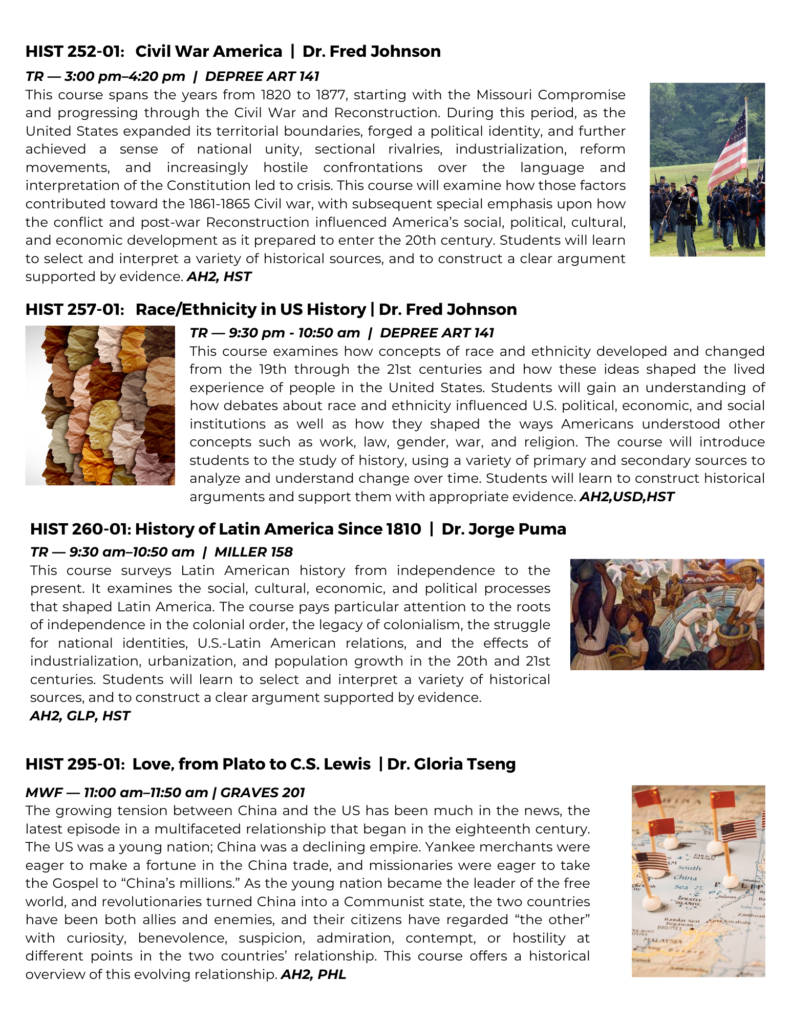
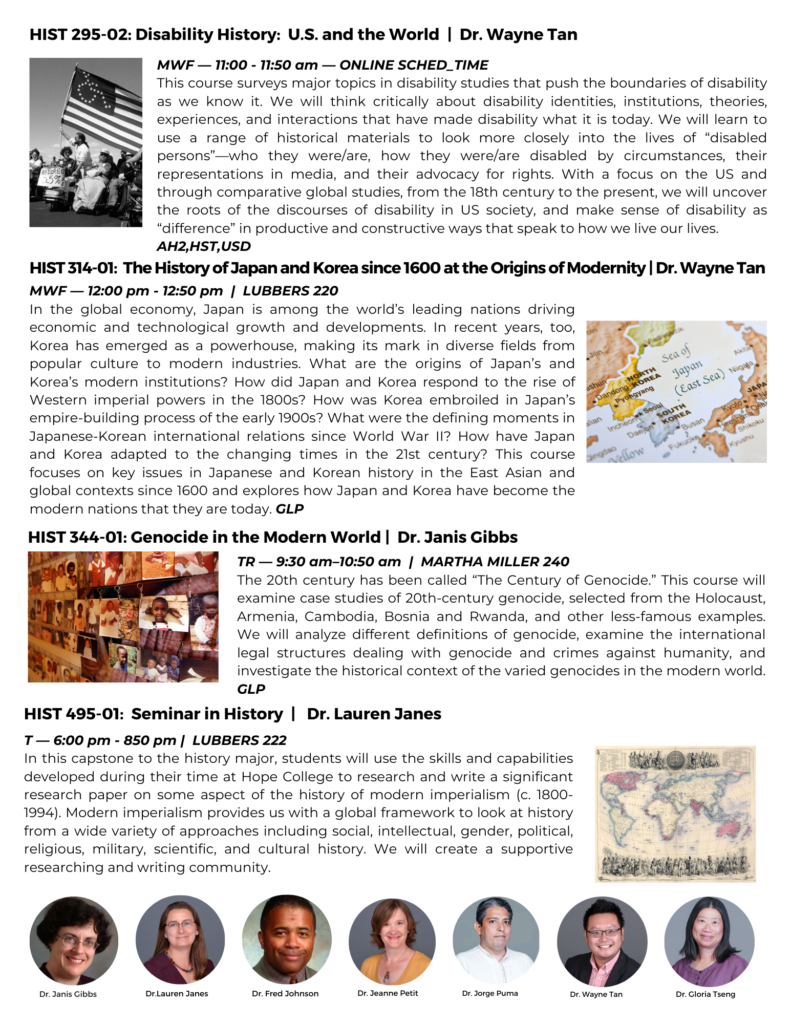
Pre-Registration Advising March 18 – 29
Registration April 2 – 5
Take a look at our upcoming offerings as you begin to plan. Be sure to make an appointment with your advisor if you are not sure which History classes to take in the Fall.




Andrew Silagi, “My Take: The Importance of Reading Fiction Together,” Holland Sentinel, November 23, 2023, Article link
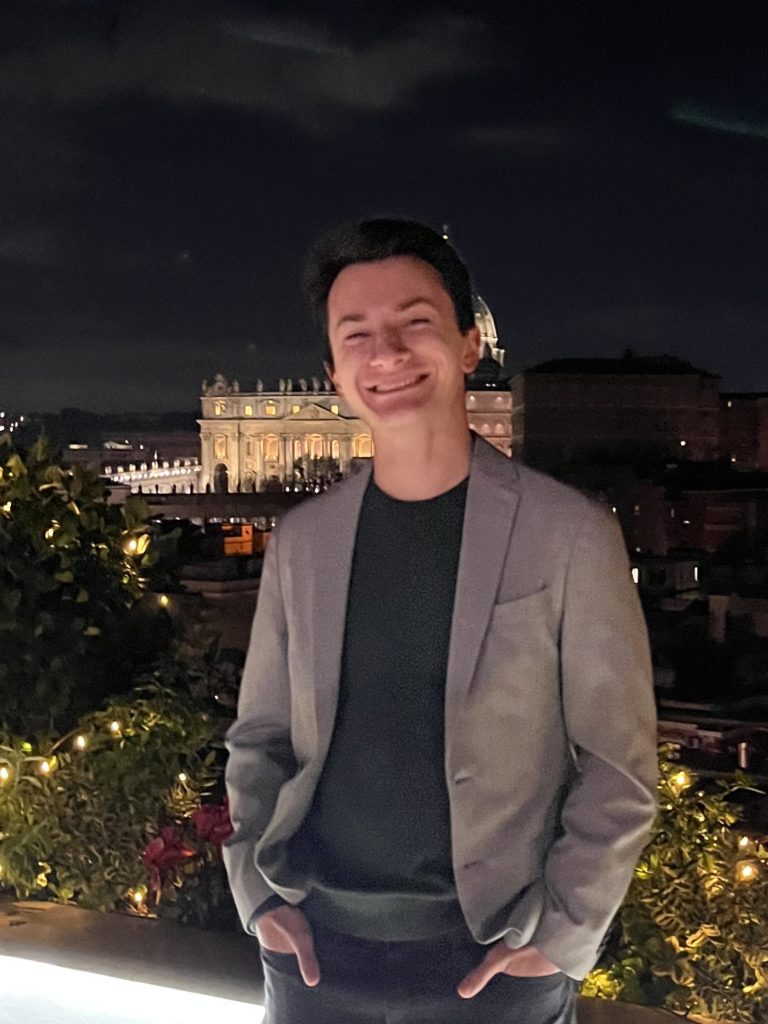
When I first saw the “Barbie” movie this summer, I was expecting the film to have a lot of commentary on women in the United States. After watching the film, I remember wrestling with it and what it says about the role of fiction.
Fiction is not like editorials: It is not meant to outright say the opinions of the author on a particular issue. Instead, through a captivating story, the creator can challenge the reader or viewer and get him or her to think about the topic in a new way. Lifelike characters and vivid descriptions of conflict and relationships often bring urgent and underrepresented issues to the forefront of society’s discourse because of fiction.
At their best, these stories refrain from telling those who engage with them how or what to think but instead compel them simply to think deeply and uncomfortably about these issues.
“Barbie,” a good example of this, brought debates specifically on the modern feminist movement into conversation in a new way through the tools of humor and satire. Often, the best part of watching films like Barbie for me is the conversation that I can have with my friends about the issues discussed in the movie, which serves as a time to honestly opine and wrestle with our gut reactions and thoughtful observations.
While the video medium has taken over much of the creative appetite for the younger generations, written fiction is a necessity that we continue to try to encourage young people to enjoy. In a country that often struggles with a lack of civil discourse, reading, particularly in community, is a beacon of light.
For the past nine years, the NEA Big Read Lakeshore has realized that this is true not only for the nation, but specifically for West Michigan as well. This year, the selected books press into challenging topics and allow us to come together to deal with these issues together.
Despite the ideological tension in West Michigan, the power of reading, especially reading fiction, has the power to bring communities into honest and humble conversation surrounding the powerful stories that are told by humans.
Two of the selected Big Read books for 2023 exemplify this notion masterfully. The Middle Read book, New Kid by Jerry Craft, through colorful and clever illustrations, tells the story of a young black student’s experience transferring to a majority-white private middle school. Craft weaves together universal experiences of struggling to find friends at a new school with specific struggles like being one of the only students from one’s ethnic and economic background there.
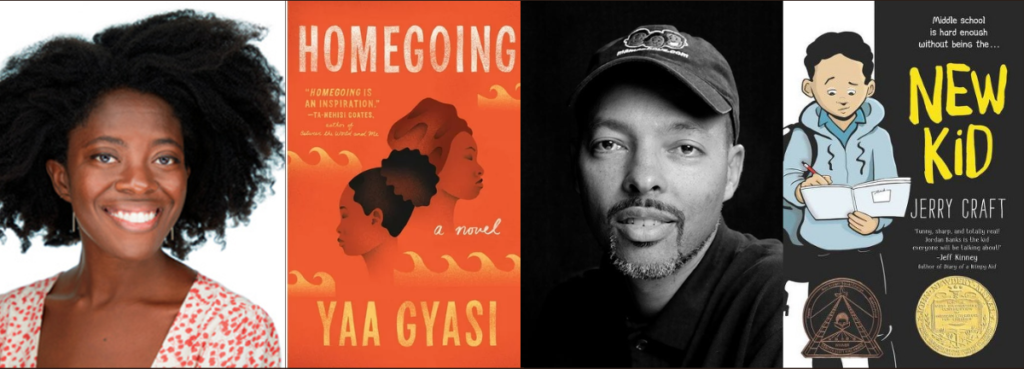
Homegoing, by Yaa Gyasi, the selected book for the Big Read 2023, does something similar with the issue of the generational trauma and disparity brought about by the trans-Atlantic slave trade. The author creates a detailed story of two half-sisters and the way the slave trade completely changed not only their lives, but the trajectory of their entire lineage.
While both of the issues tackled by New Kid and Homegoing are uncomfortable and will garner plenty of different opinions, one must have the humility to dive headfirst into these enriching discussions. Reading these books is beneficial to anyone in West Michigan, and instead of staying isolated by themselves or in their ideological bubbles, the NEA Big Read initiative gives us the unique opportunity to honestly wrestle with these topics in a community that values hard conversations and the sometimes uncomfortable observations about our own biases and shortcomings.
The best art does not necessarily affirm the views we already have but instead challenges us to rethink these perspectives and listen to those of others. Jerry Craft helps us see both the universality and uniqueness of one black boy’s experience with middle school in New Kid in an accessible graphic novel format. In Homegoing, Yaa Gyasi does not tell us what to think; rather, she encourages us through the beautiful medium of fiction to think in a new way at a long-examined issue in our nation’s history.
— Andrew Silagi is a Senior at Hope College studying Secondary English and History Education. He is a section leader in Chapel Choir, a member of the improv team Vanderprov, and a member of the Emmaus Scholars, among other things. He enjoys rollerblading and asking big questions in his free time.
Hope College Public Affairs and Marketing. (2023, October 25). Book On Blindness in Early Modern Japan Receives Two Awards [Press release].
The book “Blind in Early Modern Japan: Disability, Medicine, and Identity” by Dr. Wei Yu Wayne Tan of the Hope College history faculty has received two awards for excellence from professional associations.
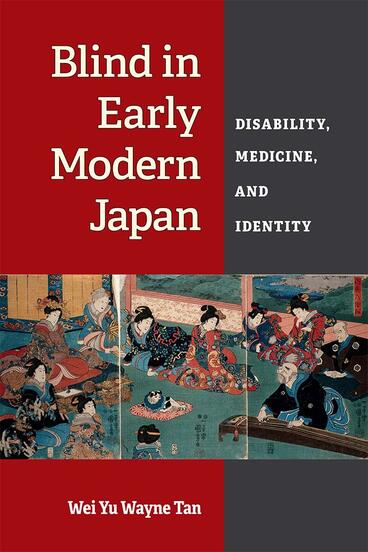

The book, published by the University of Michigan Press in 2022, covers the Edo Period (1600-1868) and examines how blind people in Japan were able to thrive, gaining power and respect in society, through prominence in a range of professions. It has won the American Historical Association’s 2023 Patricia Buckley Ebrey Prize for a book on Pre-1800 East Asian history, and the 2023 Outstanding Book Award from the Disability History Association.
The American Historical Association (AHA) offers annual prizes honoring exceptional books, distinguished teaching and mentoring in the classroom, public history and historical projects, with more than 1,300 submissions for the nearly 40 different awards that the association is presenting this year. The Patricia Buckley Ebrey Prize recognizes a distinguished book in the history of China proper, Vietnam, Chinese Central Asia, Mongolia, Manchuria, Korea or Japan prior to 1800. It is named for an internationally respected historian of China who is a professor emerita at the University of Washington at Seattle.
In its announcement, the Disability History Association (DHA) noted that “the depth and breadth of this year’s submissions, as well as the individual works, are a testament to the continued vitality of disability history and to its capacity for expanding the historical discipline more broadly.” The DHA praised Tan’s book in particular as “an impressive piece of scholarship” that “reveals new understandings of the relationships between medicine/systems of medicine and being blind, as well as how (a non-Western) religion contributed to the meaning and experience of being blind.”
Tan, an associate professor of history at Hope, wrote “Blind in Early Modern Japan” to provide a new way of understanding not only disability but also history and culture.
“It’s a less traditional way of telling the history of a place,” he said. “It allows us to look not only into the institutional background of disability, but also to look at sources that tell us about everyday life and see how Japanese society functioned, and to include marginalized voices to tell a different side of history and to reexamine our assumptions about disability.”
The book focuses especially on a guild of blind traveling musicians that also led a network of other guilds, in fields such as massage and acupuncture, that consisted of blind people. United through their strong guild structure, they were even able to monopolize some trades.
“In the United States and Europe, we don’t see this organization of blind people and blind professionals,” Tan said. “While we tend to think of disability in negative terms, the historical narrative that I outline for Japan is more complex. There were blind people who worked within the system and gained some advantages for themselves, but also many others who were left out and even exploited.”
The awards from the AHA and DHA aren’t the first acclaim that “Blind in Early Modern Japan” has received — it previously earned praise from numerous reviewers. For example, “Choice 360” of the Association of College and Research Libraries featured the book in conjunction with its commemoration of July’s Disability Pride Month, summarizing it as “highly recommended” and calling it an “important contribution to disability studies.” In its review, the journal Social History of Medicine said, “More than simply presenting Tokugawa Japan as a case study in the larger corpus of the history of disability, it encourages scholars to reconsider approaches to writing about blindness and visual impairment.”
“Blind in Early Modern Japan” chronicles the beginning of a story that Tan has been exploring for more than a decade. He initially became interested in the topic during his first visit to Japan in 2009, when he noticed extensive infrastructure for people with visual impairments that included audio cues and tactile indicators at intersections for pedestrians.
Since the 2022 book’s publication, he has been conducting research for a new volume that will carry the story forward in time, beginning in 1868 with the Meiji Restoration that reestablished imperial rule and continuing through the end of World War II in 1945. “I’m interested in how disability from the early modern period became disability in modern Japan, with a focus on science and medicine as Japan started to form itself into a modern nation-state increasingly influenced by Europe and the United States,” he said.
Tan has been a member of the Hope faculty since 2016, and was previously an Andrew W. Mellon Postdoctoral Fellow in the Humanities at Dartmouth College. He has presented his past and current research at professional meetings, including the National Endowment for the Humanities Summer Institute on the Global Histories of Disability, the Association for Asian Studies, the American Historical Association and others. His publications cover historical topics about Japan and East Asia from the 17th century to the present, including disability in modern East Asia, and acupuncture and anatomy in East Asian medical thought. He teaches courses in world history, Japanese history, East Asian cultural history, Russian history, disability history/studies, pandemics and social history, and the history of science and medicine.
The American Historical Association promotes historical work and the importance of historical thinking in public life. Incorporated by Congress in 1889, its mission to enhance the work of historians also encompasses professional standards and ethics, innovative scholarship and teaching, academic freedom and international collaboration. As the largest membership association of professional historians in the world (over 11,000 members), the AHA serves historians in a wide variety of professions, and represents every historical era and geographical area.
The Disability History Association is an international non-profit organization that promotes the study of disabilities throughout history, including the history of individuals or groups with disabilities, perspectives on disability, representations/constructions of disability, policy and practice history, teaching, theory, and disability and related social and civil rights movements. Membership is open to scholars, institutions and organizations, and others working in all geographic regions and all time periods.
Advising week starts October 16th
Registration begins October 30th
Take a look at our upcoming offerings as you begin to plan. Be sure to make an appointment with your advisor if you are not sure which History classes to take in the Spring.

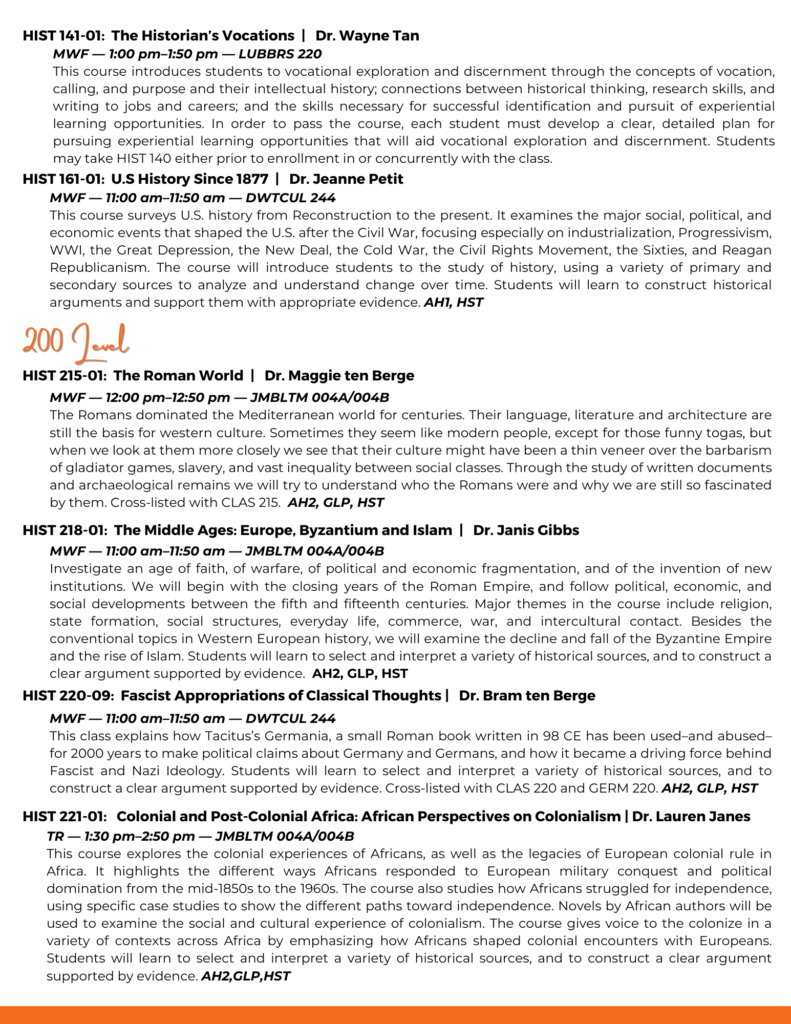


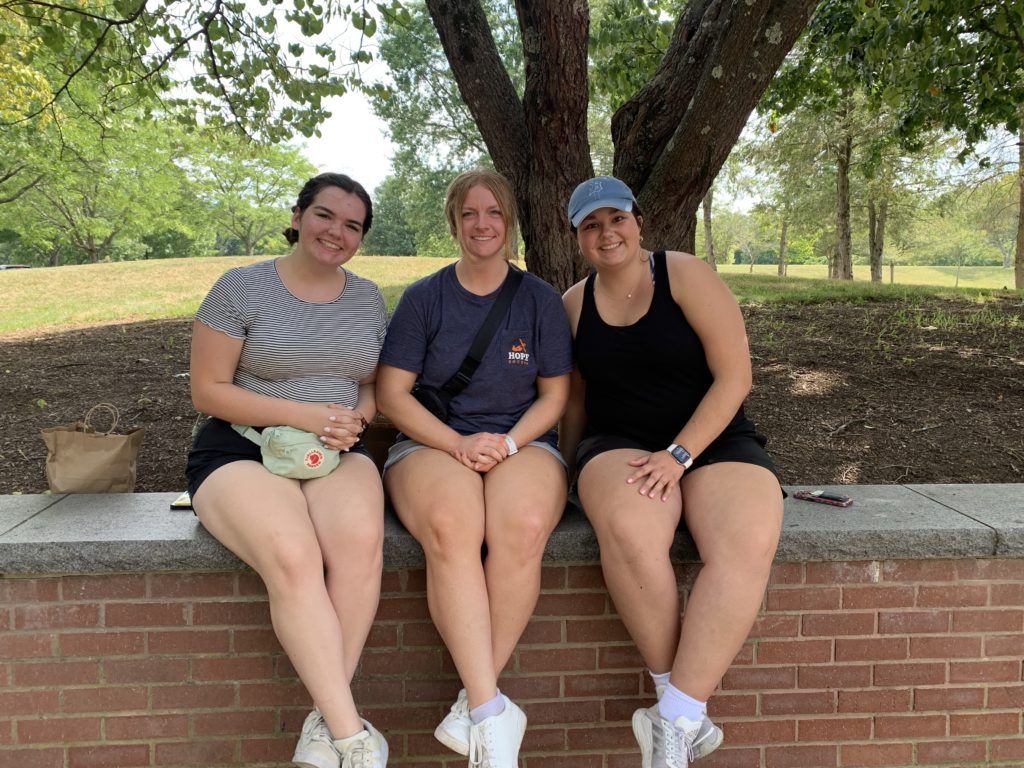
Hearing about the man who’d dedicated his life to eliminating the cancer of slavery from the United States was okay, but Hope College scholars Madison Coers, Kylie Sneller, and Katherine Dirkse wanted more. During their spring 2023 course Civil War America: Disruption & Destiny, winter weather forced the cancellation of a class trip to Harper’s Ferry, West Virginia. Madison, Kylie, and Kate had been excited to see where abolitionist John Brown had raided the federal arsenal on October 16, 1859, seeking to get free Blacks, Black slaves, and anti-slavery Whites to join him in a crusade to crush America’s brutal system of human bondage. Faced with not being able to make the trip, the scholars were disappointed but undaunted.
Madison, Kylie, and Kate moved forward, learning all they could about the life and legacy of John Brown who award-winning documentarian, Ken Burns, in his 1990 epic production “The Civil War,” described as “The Meteor” foreshadowing America’s prolonged, bloody civil conflict.
When the spring 2023 semester ended, the three scholars continued their examination to gain deeper insight into Brown’s attack on Harper’s Ferry which, along with enraging Southerners, caused a direct confrontation with the United States military.
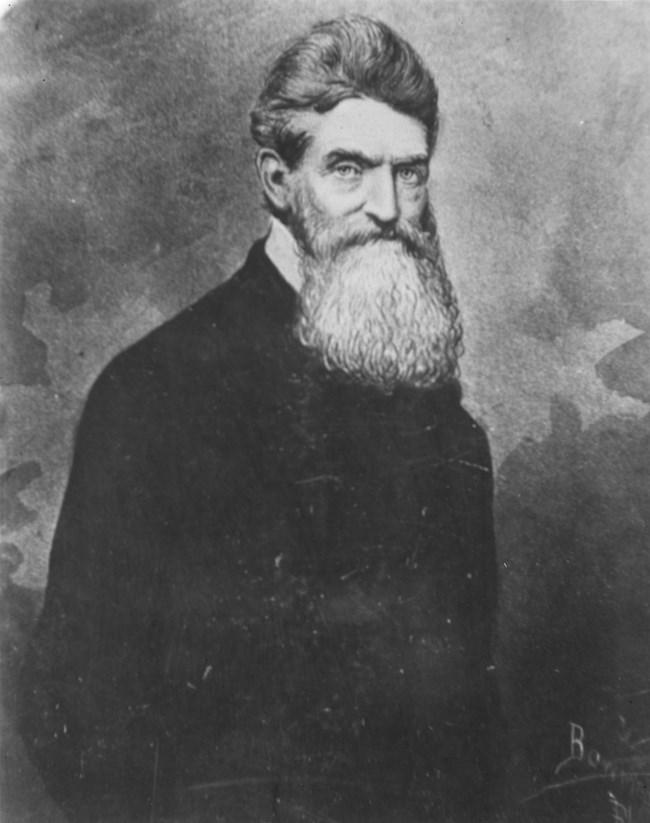
Each new revelation convinced these determined researchers that the life and times of John Brown weren’t just history. They contained lessons and warnings for 21st-century Americans. Fortified by that motivation, Madison, Kylie, and Kate dissected the unraveling of Brown’s plan, starting from the moment he launched his attack, and continuing as circumstances steadily worsened for him and his raiders.
The townspeople of Harper’s Ferry proved more resilient and ferocious than Brown and his men had anticipated, and they put up a stiff resistance. Area Blacks, free and slave, stayed away, knowing that a mere raid would never be enough to eliminate the slavery which they knew to be not only oppressive but evil. Slavery had been making North America spectacularly wealthy since 1619 when a Dutch warship had delivered a cargo of twenty Africans to the English colony of Jamestown, Virginia.

After generations of being the target of slavery’s relentless violence, Blacks collectively understood that its beneficiaries would never relinquish that vile system without a fight of cataclysmic proportions. Still, a few African Americans like free Black, Dangerfield Newby, joined the raiders, and they were swiftly killed. The dead body of Newby, who’d participated in hopes of freeing his enslaved wife who was about to be sold, was mutilated and left out in the open on a Harper’s Ferry side street to rot for days.
The desire to know what had caused the United States, “conceived in liberty and dedicated to the proposition that all men are created equal,” to, by 1859, be so economically dependent upon a system of human bondage reinforced for Madison, Kylie, and Kate the need to see Harper’s Ferry with their own eyes.
Professors get energized when encountering students who possess such impassioned intellectual curiosity like the kind displayed by Madison, Kylie, and Kate. Their enthusiasm was irresistible, so on Friday, August 11, 2023, we all set out for Harper’s Ferry, West Virginia. Early Saturday we took the short trip from our hotel in Maryland to Harper’s Ferry, crossing a bridge over the Potomac River.

There, Madison, Kylie, and Kate saw the dangerous geography that had challenged both John Brown and his raiders in 1859, and the Union and Confederate forces who’d battled for the town during the Civil War (April 12, 1861 – April 9, 1865).
Surrounded by steep, craggy, mountains strewn with mammoth, forbidding boulders, we went from Maryland, into Virginia, and into West Virginia in less than five minutes. Once in Harper’s Ferry we drove to the Bolivar Heights battlefield, overlooking the town and walked the ground. Although not well-known like Antietam or Gettysburg, the Bolivar Heights battlefield was the scene of significant struggle during the Civil War, because Harper’s Ferry was a strategic location for both the North and the South.
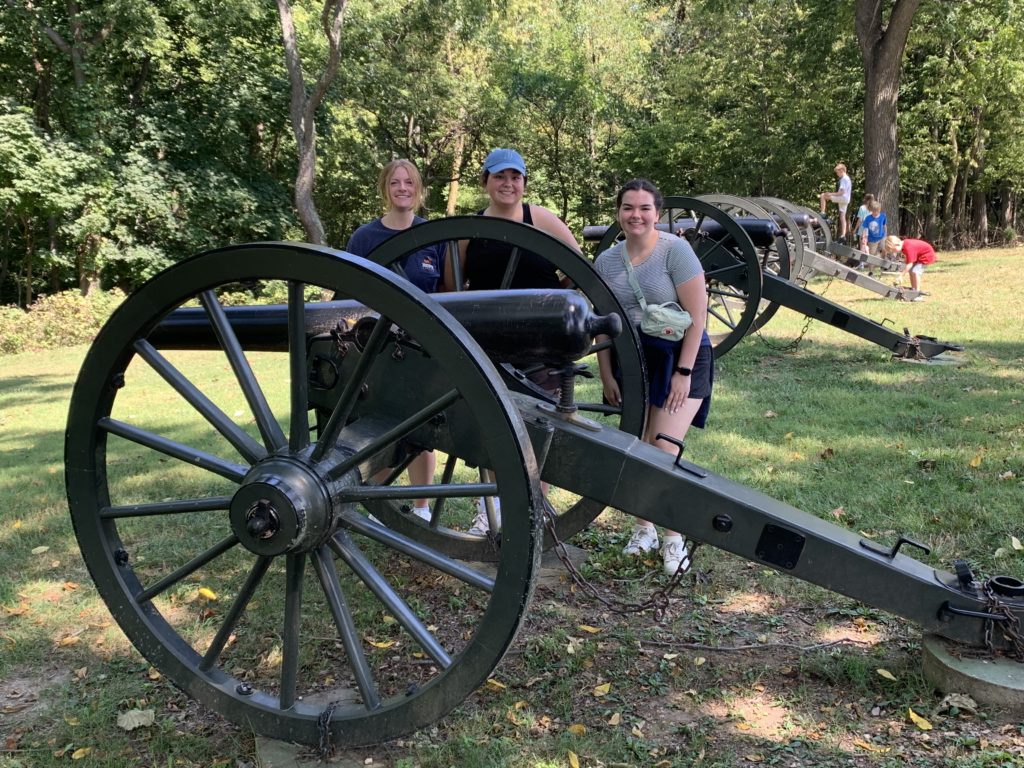
Hundreds of tourists were visiting Harper’s Ferry that weekend, but they didn’t get to experience the historic site like Madison, Kylie, and Kate. On the banks of the Shenandoah River, the scholars stood mere inches from the flowing waters of that mighty river which had once turned the water wheels of cotton and grain mills on Virginius Island, adjacent to Harper’s Ferry.
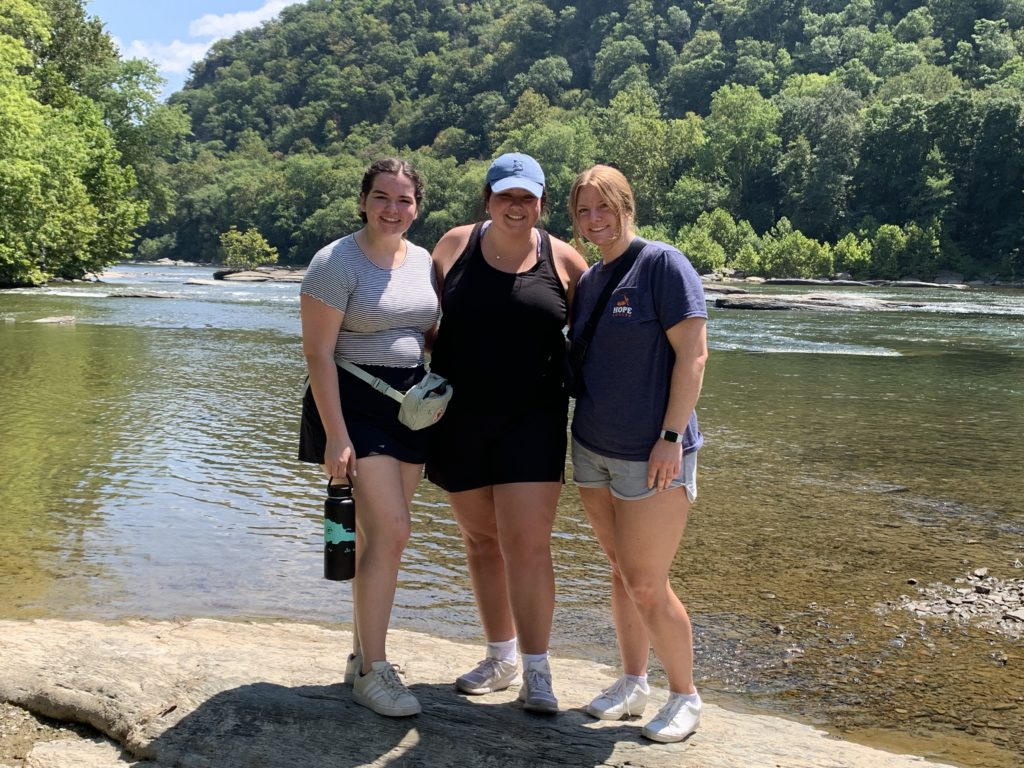
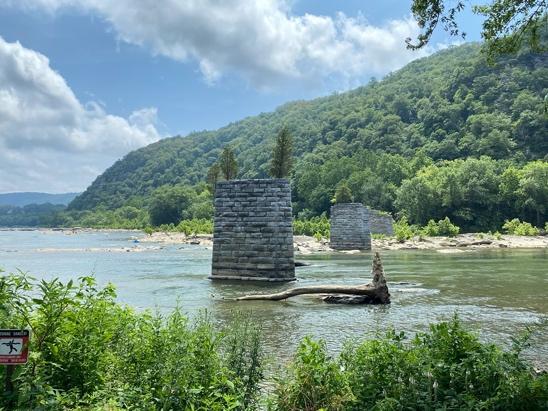
They walked alongside the tracks of a railroad which, during the Civil War, had been a magnet for destruction by Confederate raiders like General Thomas Jonathan “Stonewall” Jackson. They looked out across the Potomac at stone supports, the only remains of a Baltimore & Ohio railroad bridge that Jackson had destroyed so often that the B&O finally stopped attempting repairs.
Madison, Kylie, and Kate walked through the town’s Provost Marshal’s (military police) office and noticed the narrow doorways, lower room ceilings, and smaller furniture, gaining a good idea of the smaller stature of 19th-century Americans.
The three scholar-researchers were silent and reflective when they stepped into the firehouse, known as John Brown’s Fort, where he and his raiders made their last stand. Outnumbered and outgunned by a military detachment sent by train from Washington, D.C., Brown had run out of options. Detachment commanders Colonel Robert E. Lee and his subordinate, James Ewell Brown (Jeb) Stuart, then members of the United States Army, ordered Brown to surrender. He refused. The military detachment stormed the firehouse, ending the raid. Ten of Brown’s men had been killed, including two of his sons.
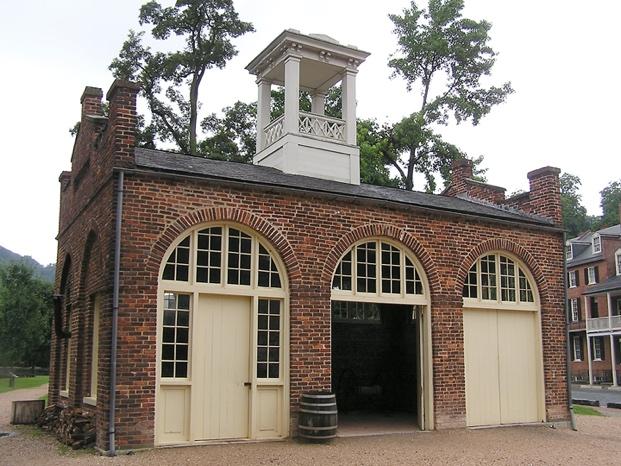
Standing in the location of the violent incident that sent John Brown, first, to prison in nearby Charlestown and, finally, to the hangman’s noose, Madison, Kylie, and Kate saw with their own eyes the landscape, historical explanations, and images of people who, in their own time, fought to make their nation a more just society. Their legacy joins with the struggle of people seeking to achieve justice for all in 21st-century America.
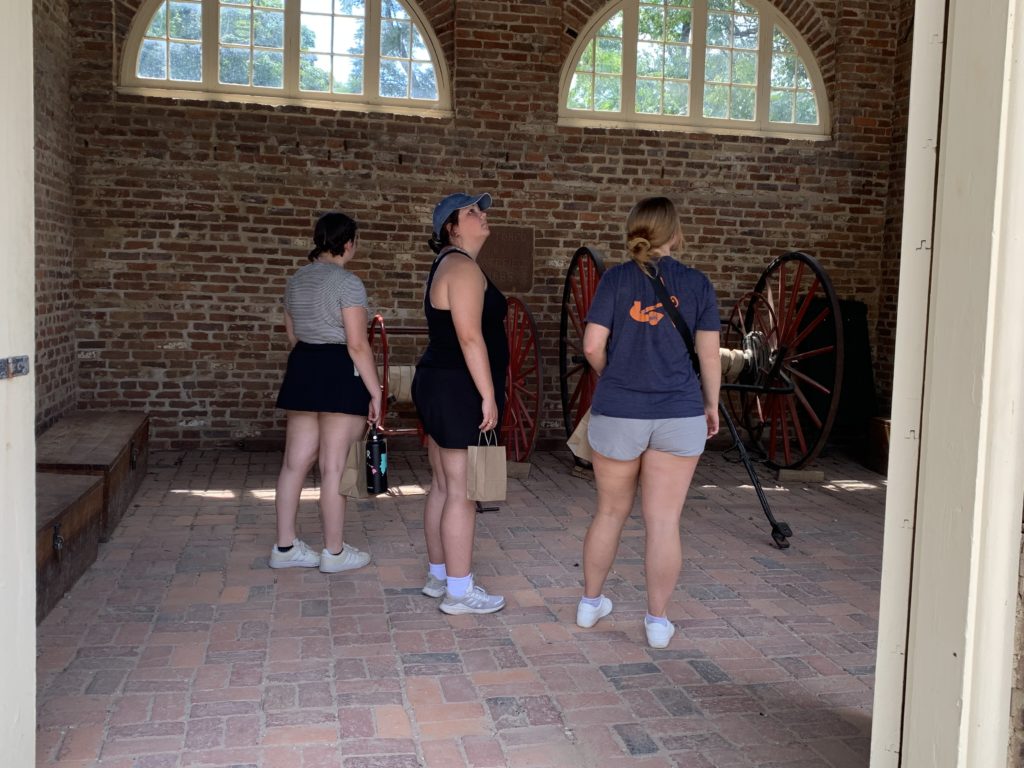
On Sunday, August 13, having explored as much of Harper’s Ferry as we could, we headed back to Michigan, making a detour to Shanksville, Pennsylvania, to honor heroes who gave their lives to save others on September 11, 2001.
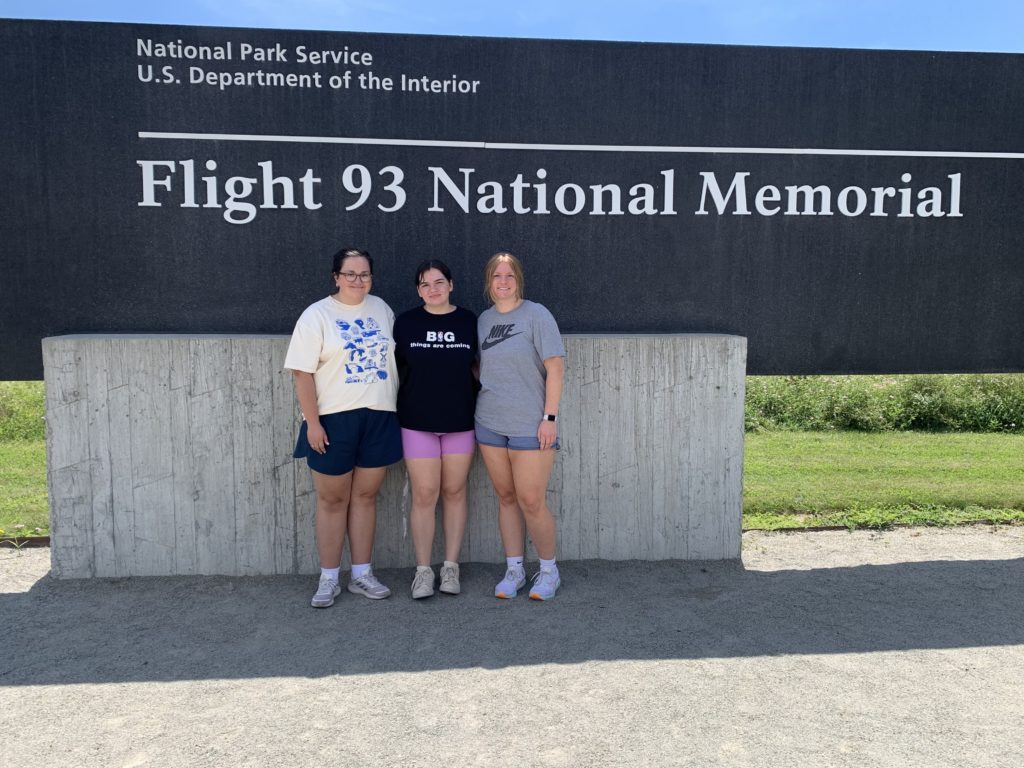
Madison, Kylie, and Kate were lost in deep reflection as they walked through the Flight 93 National Memorial, looking over exhibits of the unforgettable events of 9/11. They learned that the day had just started for the people of rural Shanksville when a hijacked commercial airliner, United 93, roared over their homes at treetop level. Windows shattered. Dishes vibrated off shelves. Car alarms blared. People dove for cover.
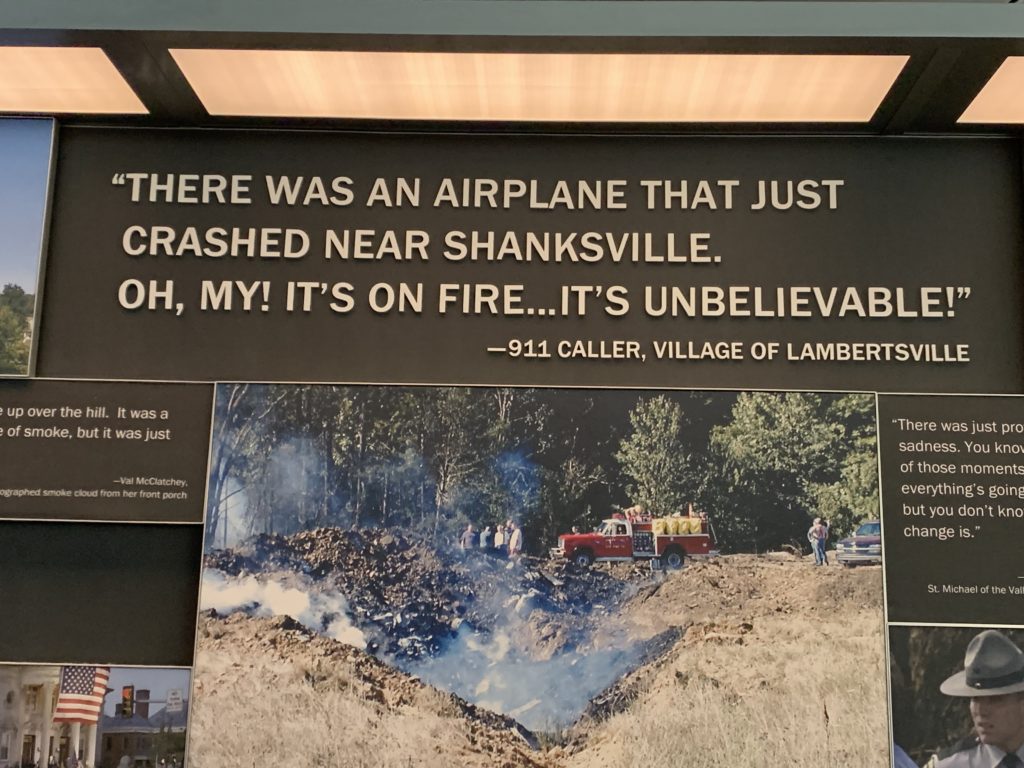
Passengers aboard United 93, learning that terrorists had used airliners to attack New York City’s World Trade Center and the Pentagon in Washington, D.C., deduced that the hijackers of their plane intended to also use it for attacking the nation’s capital.
While 9/11 happened before Madison, Kylie, and Kate were born, seeing the memorial with their own eyes helped them appreciate the shock of that day’s events. They were awestruck by the courage of passengers who’d fought back and seized control of their aircraft, refusing to let the terrorist cowards inflict more harm upon their country.
Moments before neutralizing the hijackers, one passenger, Todd Beamer, speaking with Chicago telephone operator Lisa Jefferson, asked her to recite the Lord’s Prayer with him. They prayed and then Lisa heard Todd say, “Are you guys ready?” They answered, and he said, “Let’s roll.”
When the passengers of United 93 took control of their airplane they’d been only twenty aerial minutes away from Washington, D. C. before crashing into the rolling hills of western Pennsylvania.
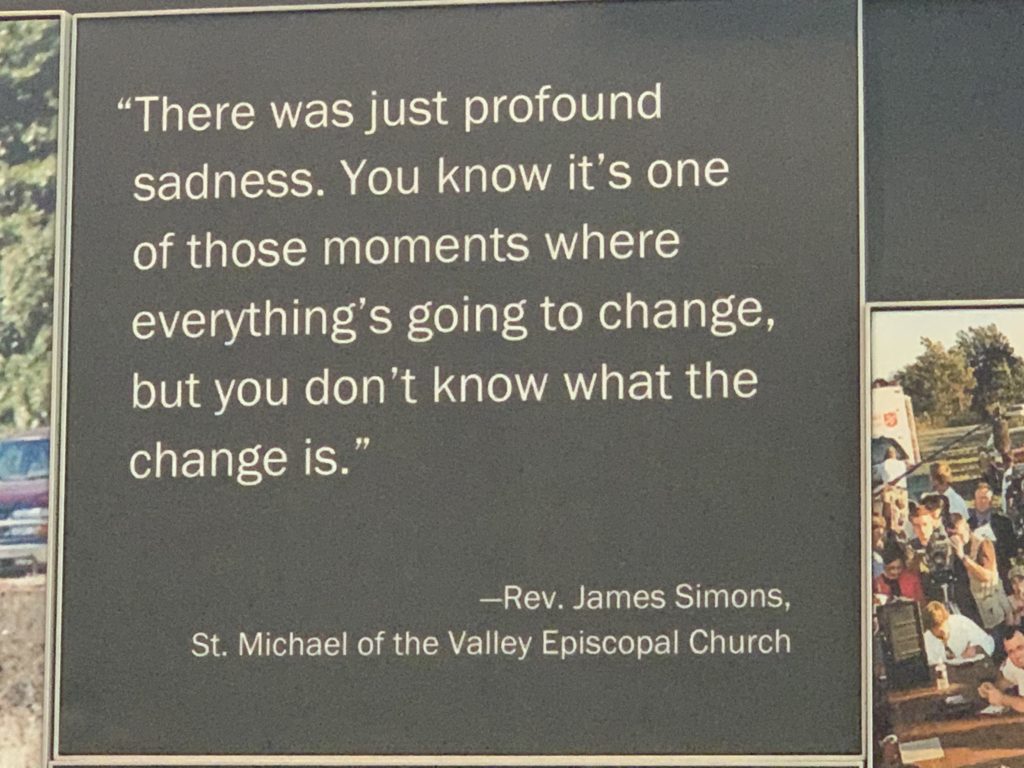
Madison, Kylie, and Kate have often heard me say that really knowing history requires going to where it happened and “walking the ground.” Be in the space where John Brown made his last stand. Hear the rushing Shenandoah River that once turned water wheels, making Virginius Island and Harper’s Ferry economic powerhouses. Stand on the side street where Dangerfield Newby’s body was left to rot. See the wounded earth, still healing from the crash of United 93.
Although separated by more than one hundred years from John Brown’s raid, Madison, Kylie, and Kate have no doubt that John Brown and his legacy remain relevant in 21st-century America. They know that the story of the passengers who prevented an atrocity on Nine-Eleven underscores the need for vigilance against national threats, foreign and domestic. They now know, understand, and feel history as scholars who’ve seen it with their own eyes.
Written by Fred L. Johnson III, Ph.D.,
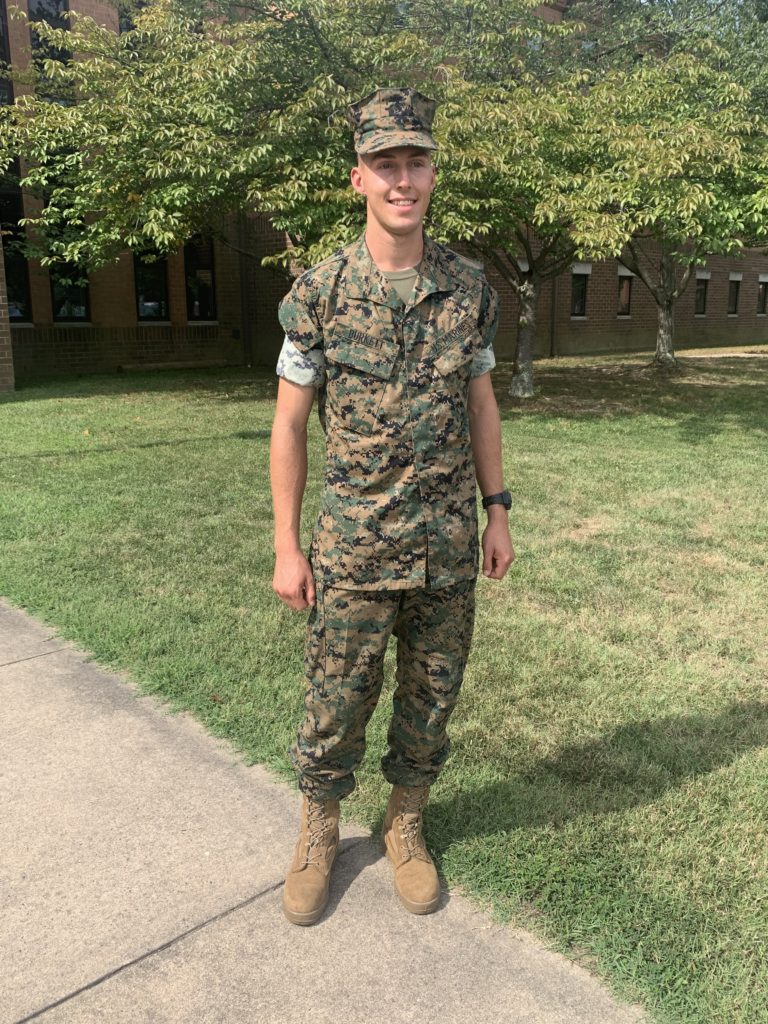
Twelve weeks of relentless pounding by Virginia’s brutal summer sun did not stop them. Hours of marching, running, and pushing themselves to perform beyond what they had once thought impossible made them determined to do more. Be better. Be excellent. They silenced inner demons of doubt to better hear the future calling them to duty and destiny. From the start until the end, May 2023 Hope College graduate, Jacob Burkett and his fellow candidates at Quantico Marine Base’s Officer’s Candidate’s School gave everything they had to earn the title: MARINE.
On August 5, 2023, newly commissioned Second Lieutenant Jacob Burkett raised his hand and swore to uphold and defend the Constitution against all enemies, foreign and domestic, against any and all threats to the United States of America. As Jake took his oath, a special guest of honor watched as the torch was passed to this new generation of warriors. Commander Everett Alvarez, Jr., the first American aviator taken captive during the Vietnam conflict, inspired the new Marines and their families with his mere presence. The grandson of Mexican immigrants, Commander Alvarez had been an A-4 Skyhawk attack pilot before being shot down near Hanoi on August 5, 1964. Commander Alvarez became the second longest-held U.S. prisoner of war (POW) in U.S. History (finally being released on February 12, 1973).
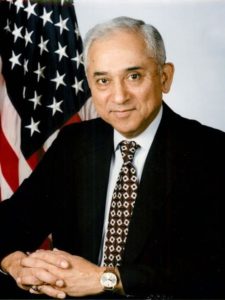
Once Commander Alvarez was recognized for his outstanding service to the United States, the graduation ceremony continued, and I reflected on the many encounters that I’d had with Jake. Although not a history major (but rather a student in Hope’s Department of Economics and Business) Jake Burkett was nonetheless, making history with his accomplishment. During the 2022 – 2023 academic year, it had been my special privilege to share with Jake my own recollections about the wonderful pride and privilege of being a Marine Corps Officer. We also discussed the sobering reality that the Marine Corps’ primary purpose for existence is to wage war in defense of the nation.
Jake was always clear-eyed about his aspirations, forging ahead to prove that he belonged in the ranks of such excellent women and men of valor who’d dedicated themselves to preserving America’s republican-democracy. We discussed giants of leadership like four-time Navy Cross winner General Lewis Burwell “Chesty” Puller; hard-hitting, no nonsense former Commandant of the Marine Corps, General Alfred M. Gray; the warrior-sage General Richard I. “Butch” Neal who, as a young Second Lieutenant during the Vietnam conflict, was instantly thrust into command of a combat unit when its leaders were killed during a firefight; and trailblazers like General Margaret A. Brewer, the Marine Corps’ first woman general officer; and General Frank E. Petersen who, in addition to becoming the Marine Corps’ first black aviator, flew combat missions in Korea and Vietnam, eventually advancing to become the Marine Corp’s first black general officer.
Jake spared no effort familiarizing himself with the latest policies and doctrines that were being implemented not only in the Marine Corps but throughout America’s defense establishment to ensure preparedness in the constantly changing environment of the international arena. He repeatedly demonstrated that he possessed the right combination of intellectual brilliance, unflinching willpower, and voluminous courage to evolve into a great Marine Officer and commander. The aspect of Jake’s character, which assured me that he’d not only be a great Marine Officer but will become an outstanding leader, is his deep desire to serve from the front. Long before I ever mentioned the principle, Jake knew that it’s better to inspire people into action rather than by flexing rank and authority. Practical and wise, though, Jake also understood (and understands) that some people require occasional vigorous applications of rank and authority, and he possesses the presence of mind, soundness of judgment, and courage to do what’s necessary in helping him and his Marines accomplish their mission.
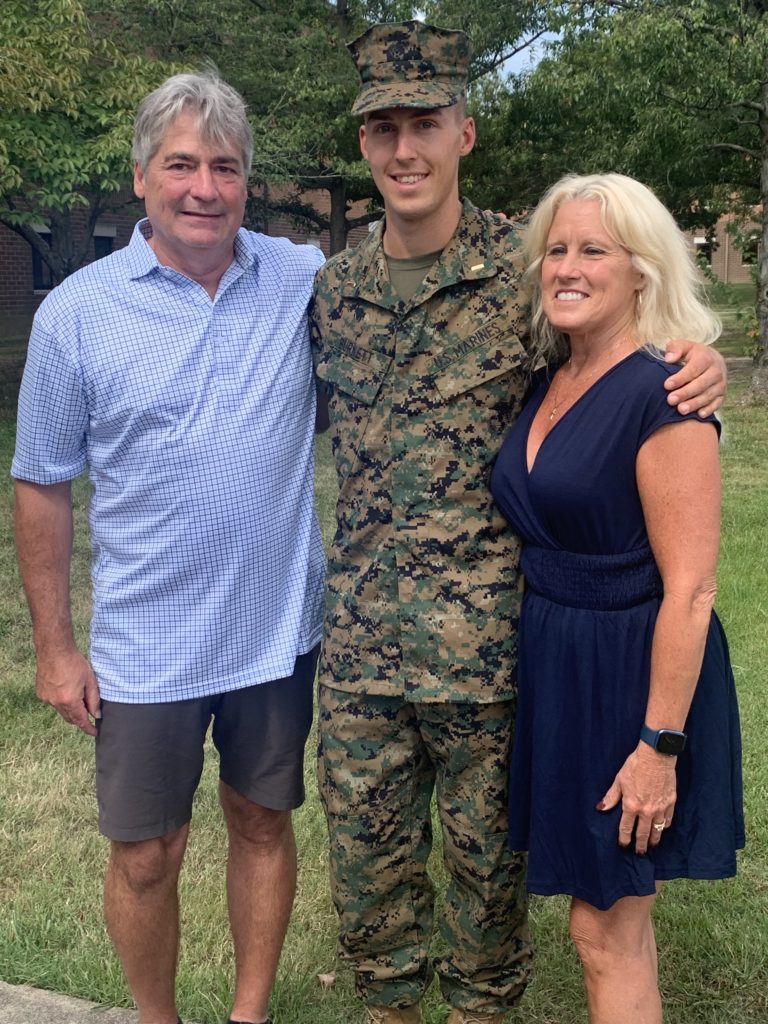
Second Lieutenant Jacob Burkett is a fine example of the collective work that’s achieved by Hope College’s staff, administration, and faculty in fulfilling the College’s mission to “educate students for lives of leadership and service in a global society.” Jake is also a son who made his parents proud on August 5, 2023 when he took his oath of office and assumed the title of United States Marine. It was a privilege and honor to sit with Jake’s family during the graduation ceremony at Quantico Marine Base’s Brown Field which proudly proclaims “We Make Marine Officers”.
Second Lieutenant Burkett, from one Marine Officer to another, I say congratulations.
Welcome to the legacy, and “Semper Fidelis” (Always Faithful).
Fred L. Johnson III, Ph.D.
Captain, United States Marine Corps (Retired)
Guy Vander Jagt ‘53 Endowed Professor of History at Hope College
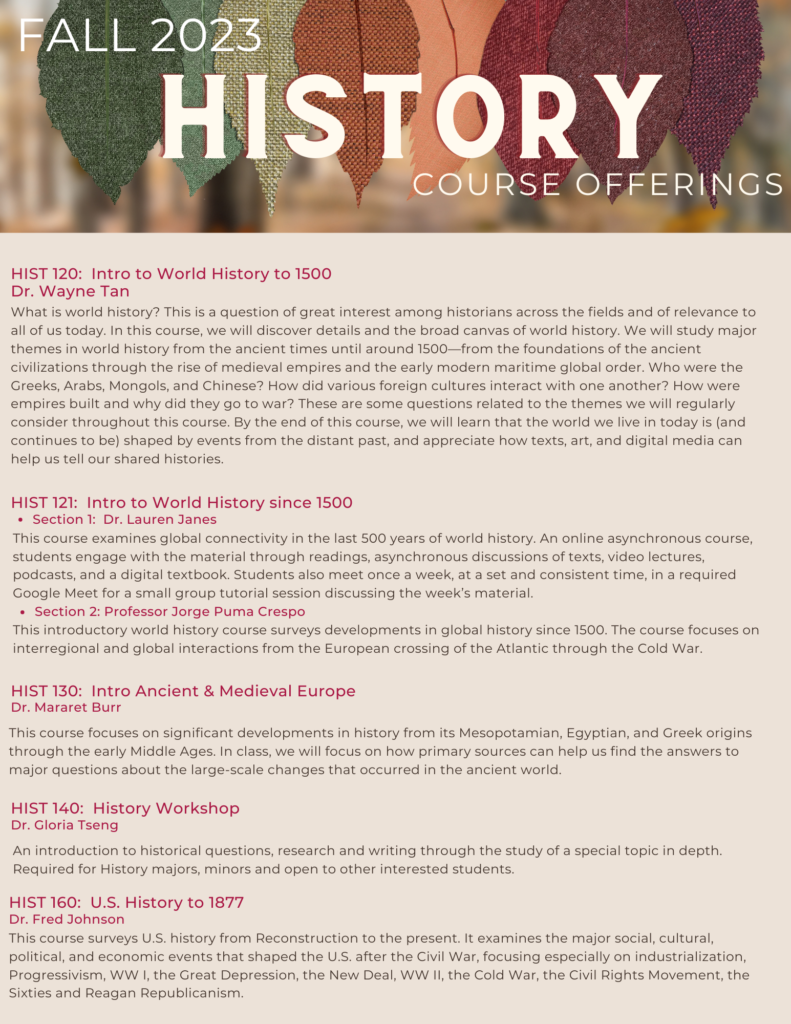


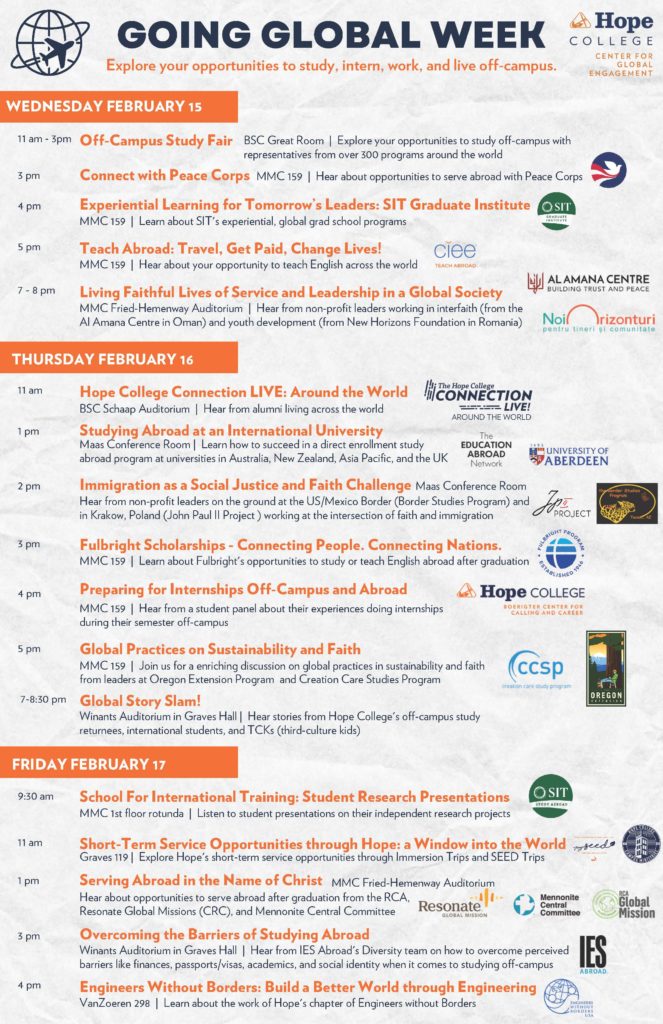
This off-site presentation is a collaboration between the Holland Museum, the Hope College History Department, and the Herrick District Library.
Friday, December 2, 2022
4:00-5:00 pm
Herrick District Library Auditorium, 300 S. River Ave.
Free Adult Program, donations encouraged
This program is part of the Holland Museum “Tales from the Archives” series which explores local history topics supported by the Holland Museum’s collection and archives. It is also a part of the Hope College History Department Colloquium Series.
For more than a century, the Ottawa County Poor Farm was a place some people called home, and a source of identity in the county’s community. But time has erased memories of its significance. This past summer (2022), Hope College students Chloe Bares, Aubrey Brolsma, and Ty Overhiser along with Wayne Tan, Associate Professor of History, worked together to find new perspectives on the Poor Farm. Using rare historical records and new digital and data analytical tools, this presentation breathes new life into stories about the Poor Farm–its residents and their lives, and its rise and decline in the timeline of the community’s history. (Holland Museum)
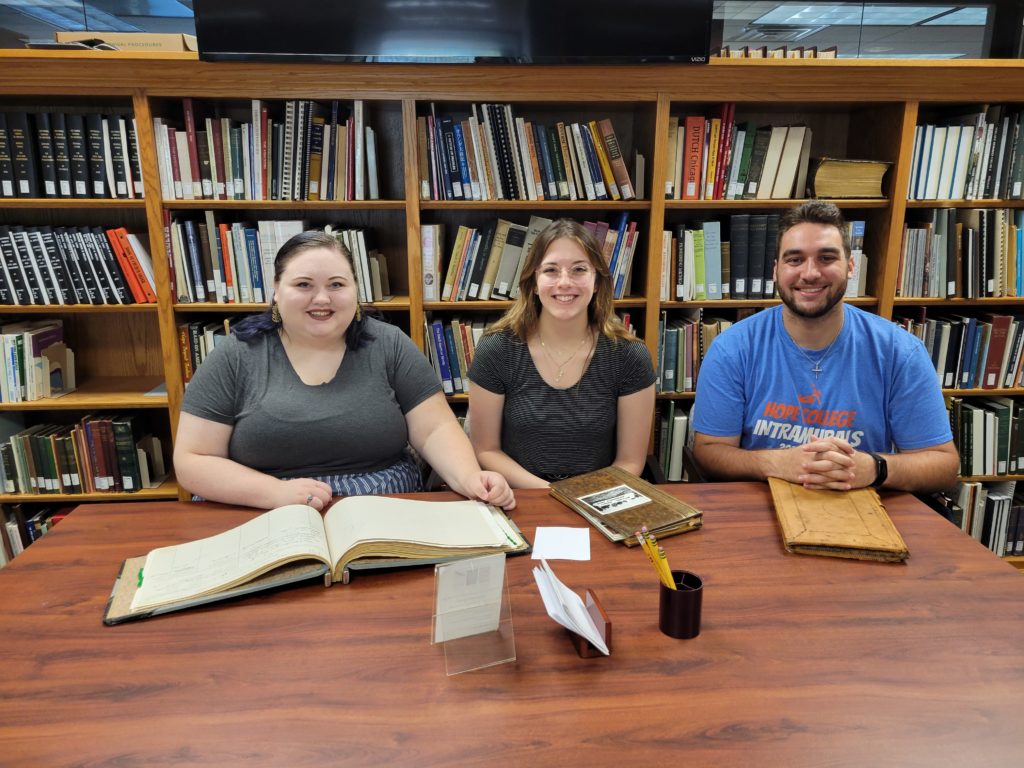
Take a look at our upcoming offerings as you begin to plan. For a complete list of upcoming classes or to see course details, including dates, times and professors, please see the Registrar’s course schedule.
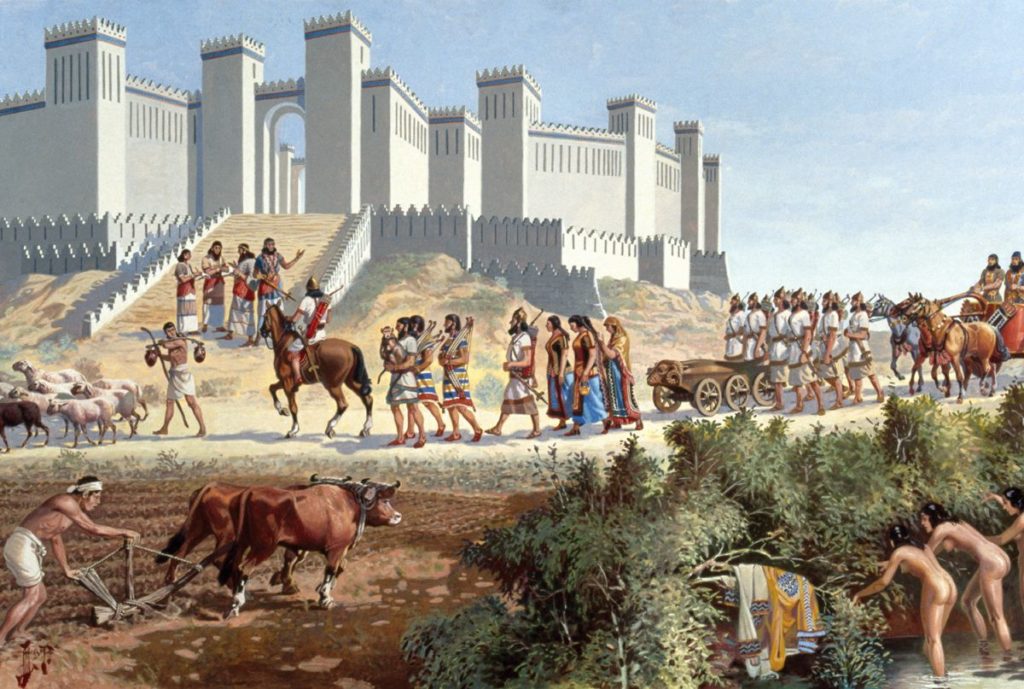
HIST 130 – 01 Intro Ancient Civilization
TR 3:00 pm – 4:20 pm | DWTCUL 247 | Burr, Margaret H
The course will focus on significant developments in history from its Greek origins through the Renaissance. It is designed to introduce the student to the discipline of history. | Credits: 4, CH1
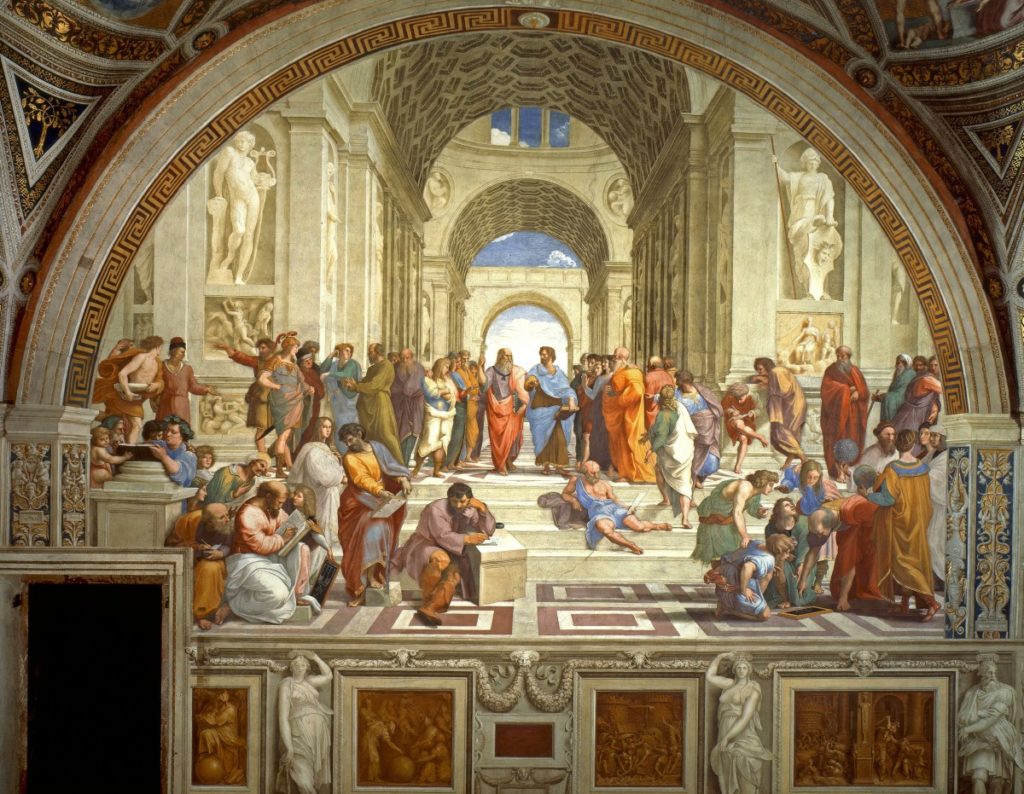
HIST 131 Intro to Modern European History
TR 9:30 – 10:50 am | DOWCTR 204 | Johnson, Fred
This course will focus on significant developments in modern European history from the Renaissance to our own time. It is designed to introduce the student to the discipline of history. Credits: 4, CH2

HIST 141 – The Historian’s Vocations
MWF 2:00 pm – 2:50 pm (meets 2nd half of the semester) | GRAVES 201 |Petit, Jeanne
This course introduces students to vocational exploration and discernment through the concepts of vocation, calling, and purpose and their intellectual history; connections between historical thinking, research skills, and writing to jobs and careers; and the skills necessary for successful identification and pursuit of experiential learning opportunities. In order to pass the course, each student must develop a clear, detailed plan for pursuing experiential learning opportunities that will aid vocational exploration and discernment. Required for History majors and minors. Students may take HIST 140 either prior to enrollment in or concurrently with the class. | Credits: 2
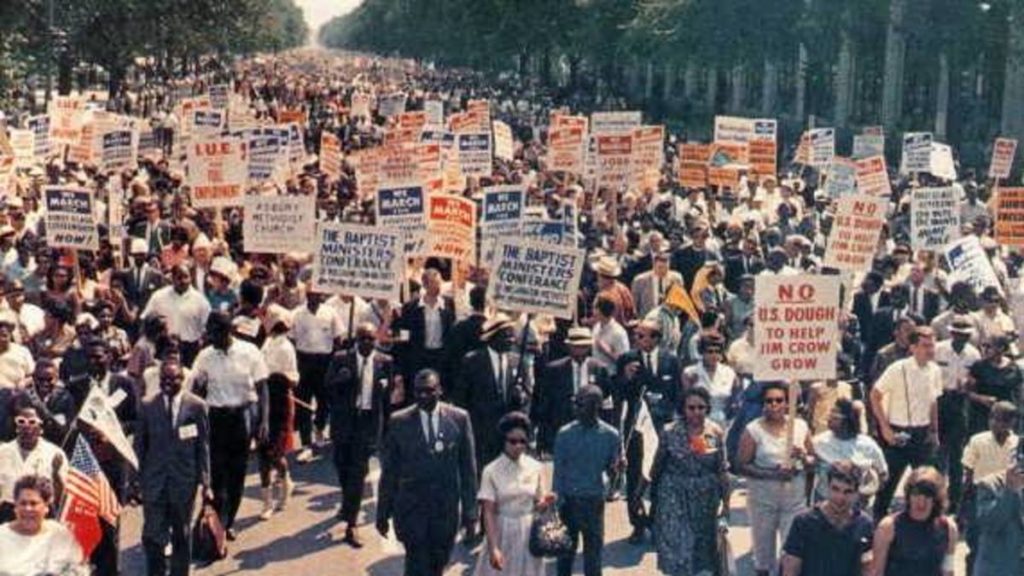
HIST 161 – U.S. History Since 1877
MWF 11:00 am – 11:50 am | Graves 121 |Petit, Jeanne D.
This course surveys U.S. history from Reconstruction to the present. It examines the major social, cultural, political, and economic events that shaped the U.S. after the Civil War, focusing especially on industrialization, Progressivism, WW I, the Great Depression, the New Deal, WW II, the Cold War, the Civil Rights Movement, the Sixties and Reagan Republicanism. | Credits: 4, GLD
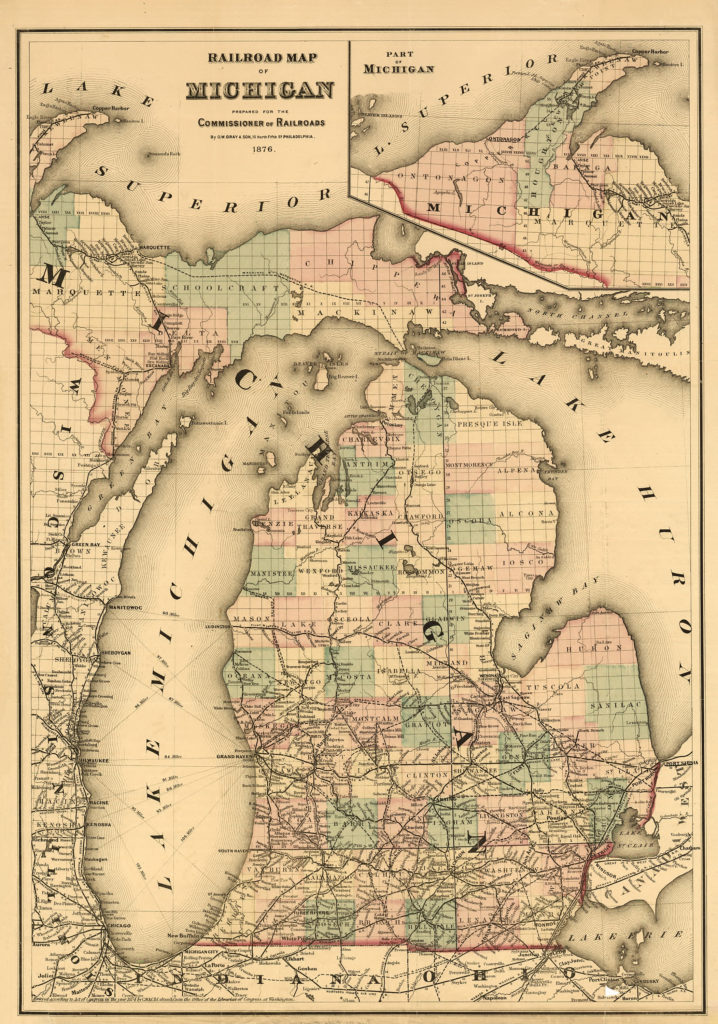
HIST 175 – Michigan History
TR 12:00 pm – 1:20 pm | Johnson, Fred L
This course is a survey of Michigan History to the present and is primarily designed for students majoring in education. The main objective of History 175 is for students to demonstrate an understanding of the chronology, narratives, perspectives, and interpretations of Michigan history from its beginnings to the present. To this end, students will: examine relationships, including cause and effect, among important events from the era; identify the sequence of these events and describe the setting and the people affected; analyze and compare interpretations of events from a variety of perspectives; and assess the implications and long-term consequences of key decisions made at critical turning points in Michigan history. | Credits: 2
HIST 200 – Historical Snapshot: The Roaring Twenties
MWF 9:30 am – 10:20 am (meets first half of the semester) | Petit, Jeanne D.
HIST 200 – Historical Snapshot: The Crusades
MWF 3:00 – 3:50 pm (meets first half of the semester) | Gibbs, Janis
This course is designed to allow the exploration of some narrow moment in time (early imperial Rome) or some particular historical issue or problem (such as World War II, Christianity in China, or women in early Modern Europe). The content and emphasis of each section is determined by the instructor. Students may repeat the course for credit as topics change. No more than two 2-credit HIST 200 courses may be counted toward the major, and no more than one toward the minor. | Credits: 2
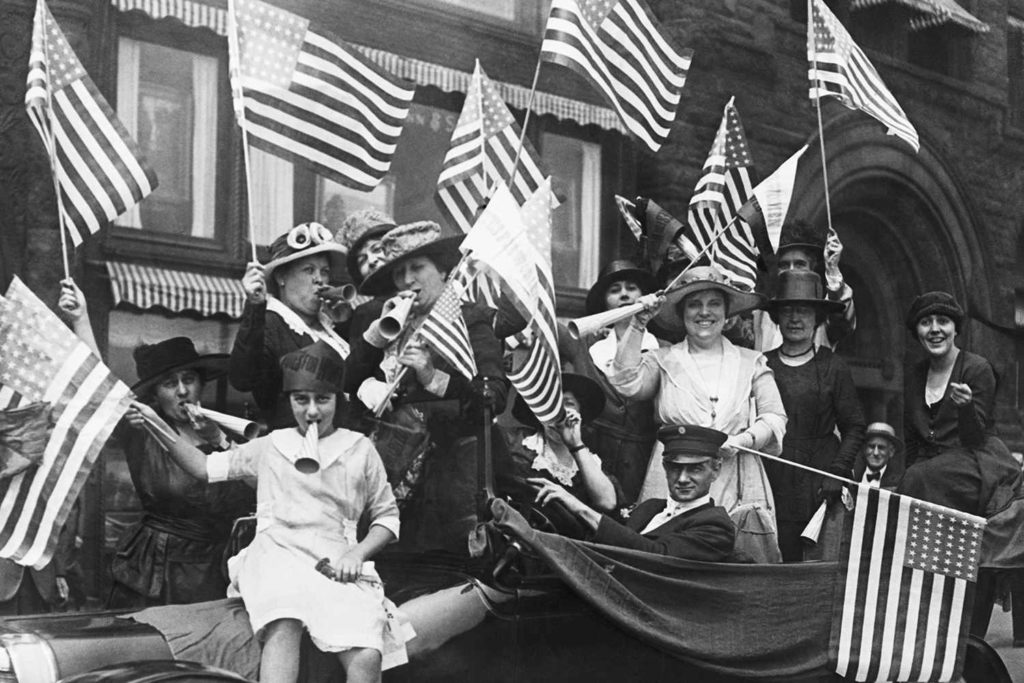

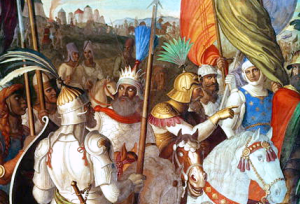
HIST 207- Historical Snapshot: Intro to World History to 1500
TR 1:30 – 2:50 pm | Burr, Margaret
This introductory world history course surveys developments in global history from prehistory until about 1500. The course focuses on regional, interregional and global interactions from the beginning of written history to the European crossing of the Atlantic. Credits: 4, CH1
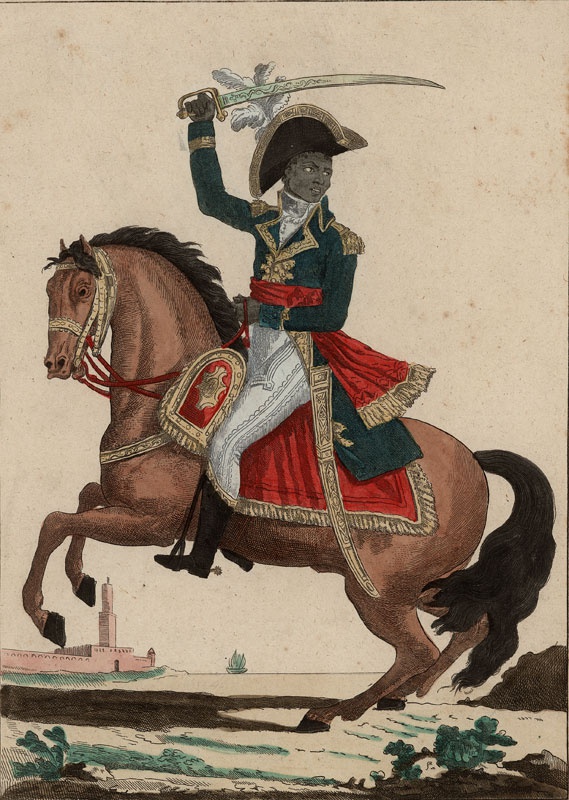
HIST 208- Historical Snapshot: Intro to World History Since 1500
Online | Janes, Lauren
This introductory world history course surveys developments in global history since 1500. The course focuses on interregional and global interactions from the European crossing of the Atlantic through the Cold War. Credits: 4, CH1, GLI
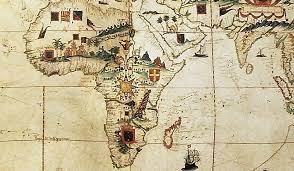
HIST 221- Colonial and Post-Colonial Africa: African Perspectives on Colonialism
TR 12:00 – 1:20 pm | Janes, Lauren
This course explores the colonial experiences of Africans as well as the legacies of European colonial rule in Africa. It highlights the different ways Africans responded to European military conquest and political domination from the mid-1850s to the 1960s. The course also studies how Africans struggled for independence, using specific case studies to show the different paths toward independence. Novels by African authors will be used to examine the social and cultural experiences of colonialism. The course gives voice to the colonized in a variety of contexts across Africa by emphasizing how Africans shaped colonial encounters with Europeans. Credits: 4, GLI
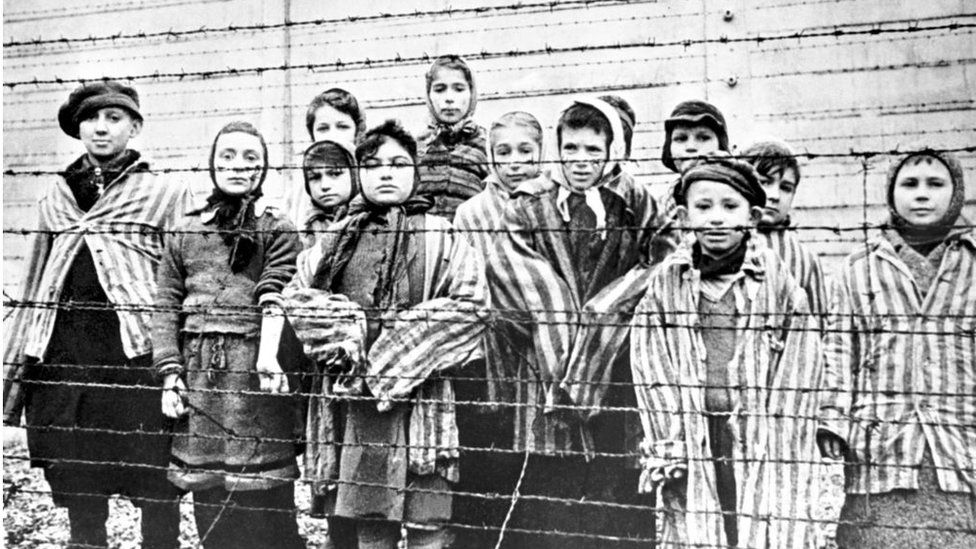
HIST 242- Twentieth Century Europe
MWF 12:00 – 12:50 pm | Tseng, Gloria
Does each century have a “spirit of the age”? What do the trenches of the First World War, the gas chambers of the Holocaust, the communist experiment, and psychoanalysis reveal about the “spirit” of the twentieth century? This course surveys the history of twentieth-century Europe from three chronologically overlapping vantage points: “the age of catastrophe,” “the age of secular ideological extremes,” and “the limits of secularism.” The events and developments examined in this course are chosen to reflect these concerns. In addition to mastering the main events and developments that have defined the twentieth century, we will seek to answer the question, In what ways are we heirs of the legacy of the twentieth-century Europe as seen from each of these vantage points? Credits: 4
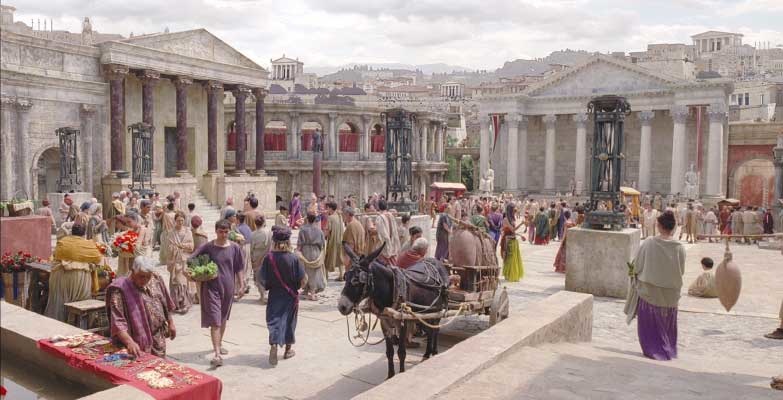
HIST 295- Pompeii and Herculaneum: Daily Life in the Roman World
TR 9:30 – 10:50 am | Burr, Margaret
These courses are designed to allow students to study geographic areas, historical periods, or particular issues not normally covered in the formal courses offered in the Department of History. In each course a professor will present lectures in his or her area of particular interest and students will engage in guided reading and research under the professor’s supervision. Credits: 4

HIST 355- U.S. Foreign Policy
TR 3:00 – 4:20 pm | Johnson, Fred
This course traces the development of United States foreign policy from the Spanish-American War to the present. In this period the United States emerged as a great world power, assumed center stage during World War II, offset the threat of the Soviet Union during the Cold War, and currently claims title to being the world’s lone superpower. Post Cold War conditions have challenged the nation to formulate policies responsive to recent manifestations of threats not yet clearly defined, including the problems of non-state actors and terrorism. Credits: 4